Correctly dehumidify cellar
Haustrocknung.ch GmbH, based in the canton of Bern, has been dehumidifying cellars throughout Switzerland since 2010. In this guide, we give you an overview of the possibilities and show you the advantages and disadvantages of the various methods.
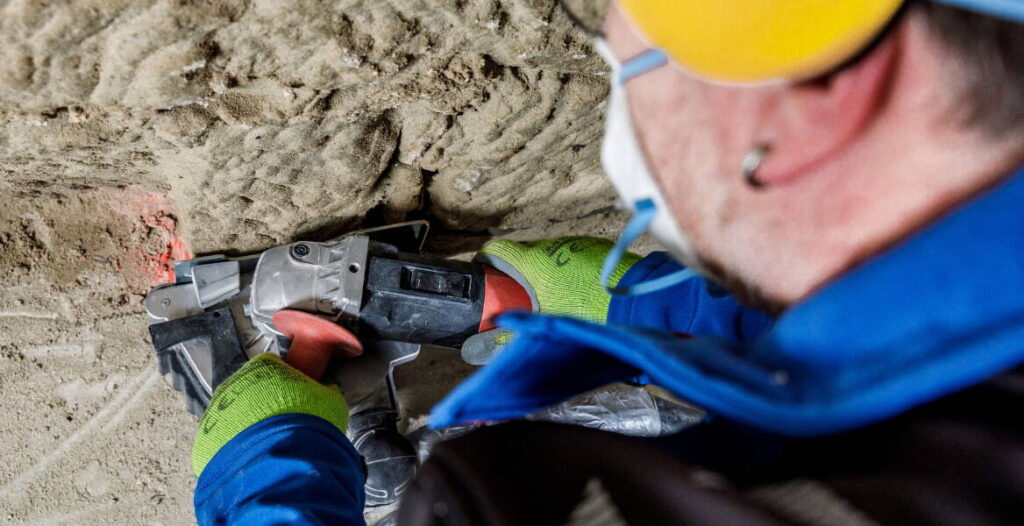
Damp cellar? What you should consider
Core statements
- Without eliminating the cause of the moisture, the use of building dryers can lead to an increase in moisture in the masonry in the medium term and thus to lasting damage to the building fabric.
- For sustainable basement dehumidification, the source of moisture must be eliminated and the building fabric must be dried.
- The horizontal barrier is a deep irreversible intervention in the structure and statics of the building, and the masonry below the barrier remains damp.
- With the inside vertical barrier, the wall remains damp on the outside; the outside vertical barrier is associated with high costs because of the earthworks.
- Electrophysical wall dehumidification actively combats moisture and is able to dry the building structure down to the basement floor, but may not be strong enough in the case of pressing slope water.
1. What are the causes of damp basements?
The most common causes of damp basements are capillary rising damp in the walls, condensation and faulty installations. Pressing moisture, on the other hand, is very rarely the problem. In most cases, several sources of moisture overlap. For this reason, it is recommended Building experts to find out the actual causes of moisture. In the following sections, we will go into more detail about the individual causes.
- Capillary rising damp in the wall: This effect, along with condensation, is probably the most common cause of damp in the basement. The real reason for rising damp is not wall leakage, but the physical properties of the building fabric. The naturally electrically negatively charged wall promotes rising damp within the wall.
- Condensation: Here, moisture condenses on cold wall surfaces, where consequential damage, such as mold growth, can occur over time. Condensation is often caused by incorrect ventilation: Warm air can absorb significantly more moisture than cold air. Therefore, airing should only take place when it is cool outside. Otherwise, moisture enters the house with the warm air, which then condenses on cool wall surfaces, similar to the outside of a cool glass bottle. Another cause of condensation is high humidity from showering, cooking or drying clothes.
- Faulty installations: Defective installations are unfortunately very common. These include external rainwater installations such as water barrels, gutters, downspouts and flat roofs; the poor condition of bricks, stones, mortar, wall bases, plaster, weatherproof paints and silicone joints; weak points in wall construction, such as cracks in the masonry or in copings; Structures adjacent to the masonry that conduct water to the masonry, including leaking windows and doors; location and condition of vents; chimneys and rain deflectors; mechanical or chemical moisture barrier coatings.
- Oppressive moisture source: Oppressive moisture sources are rather the exception. They are usually a sign that the building was constructed in an unfavorable location. Sources of oppressive moisture include oppressive slope water, springs or water veins near the building, and groundwater that periodically stands high.
2. How to dry a basement?
For the basement to remain permanently dry, both the cause of the moisture and the building structure must be dried: If the moisture comes from inside, the problem can be solved with intelligent ventilation and air dehumidification devices. In less severe cases, even targeted shock ventilation can be sufficient. If, on the other hand, the moisture enters the building from the outside, the leaks must be sealed in addition to dehumidification. There are three ways to do this:
- Vertical barrier: Large-area waterproof barrier layer such as a bituminous coating or slurry plaster seals the wall from the outside or inside.
- Horizontal barrier: injections of a sealant or the installation of a waterproof barrier layer prevents moisture from rising within the wall.
- Electrophysical basement dehumidification: Installation of low continuous electrical voltage permanently removes moisture from the basement wall down to the basement floor.
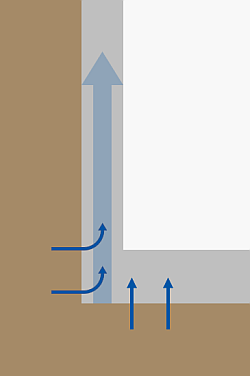
Rising damp
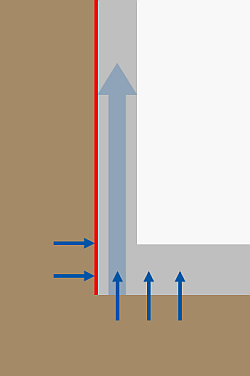
Principle of the vertical barrier
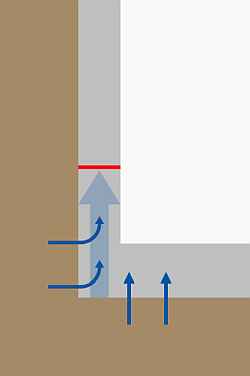
Principle of the horizontal barrier
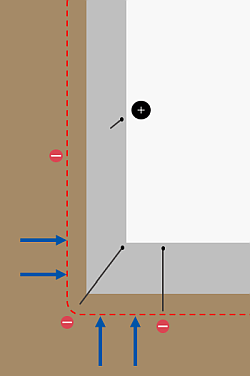
Electrophysical barrier
3. Why are dehumidifiers counterproductive?
Dehumidifiers in the form of powerful building dryers are primarily suitable for drying out buildings after water damage or during the construction phase. In contrast, they can have a counterproductive effect in the case of a constant moisture problem, if, for example, the wall absorbs moisture via the capillary suction tension of the building material. In this case, in fact, the construction dryers lead to an increase in salinity, which increases hygroscopy.
Thus, in the medium term, even more moisture gets into the masonry. Together with the moisture, further mineral salts get into the masonry. These dissolved salts can crystallize when part of the moisture on the inside of the wall evaporates. On the one hand, this salinization of the wall causes the wall to absorb even more moisture. On the other hand, the salts increase their volume during crystallization, which over time causes spalling on the wall surface and lasting damage to the building fabric.
4. What are the risks associated with manual sealing methods?

Rising damp

Principle of the vertical barrier

Principle of the horizontal barrier

Electrophysical barrier
Horizontal and vertical barriers only partially solve the moisture problem: For example, with the horizontal barrier, the areas below the barrier, such as the basement floor, remain damp. Even with the interior vertical barrier, such as the slurry plaster, the wall can continue to absorb moisture from the outside and from below.
In contrast, the outside vertical barrier effectively protects the wall from moisture from the outside, but again not from rising damp from below. In addition, the external vertical barrier is very complex and expensive to implement because the basement wall must be completely exposed.
Even if the horizontal barrier is not quite as complex as an external vertical barrier, it still requires extensive intervention in the masonry, which can impair the structural stability. It is better to refrain from this, especially in old buildings.
5. What are the advantages and disadvantages of electrophysical sealing?

Installation of the electrophysical dehumidification system DRYMAT®
Electrophysical basement dehumidification with the DRYMAT® system is capable of permanently drying out both the basement walls and the basement floor, even under high moisture loads. With the control unit and the installed electrodes an electrical potential is generated. This counteracts the suction voltage in the wall. In this way, moisture can no longer rise up in the wall. The residual moisture in the wall evaporates over time. In this way, the wall becomes permanently dry.
Thanks to the electrical potential, the dehumidified building fabric does not absorb any new moisture, but remains permanently "tight" or protected from moisture. The potential of electrophysical drying requires only minimal structural changes and thus brings a significant cost saving compared to the vertical and horizontal barrier methods. The electricity costs for maintaining the electrical potential amount to approx. CHF 50 per year.
Furthermore, electrophysical drying with DRYMAT® is risk-free for people and building fabric and does not interfere with the building statics. It is reversible and therefore suitable for the protection of historical monuments. The DRYMAT® system works according to scientifically recognized principles and is certified according to Ö-Norm B 3355-2. Finally, we give you a 10-year warranty on the control unit in Switzerland and a further 10 years from the ISO:9001 certified manufacturer, as well as a 2-year warranty on the electrode installation in accordance with SIA.

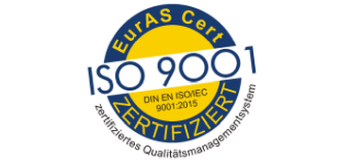
6. How much does electrophysical dehumidification cost?
The cost of electrophysical dehumidification with the DRYMAT® system for a single-family house with a floor area of 60 square meters is approximately CHF 15,000 to 20,000. This amount covers all steps of the job, including analysis, installation and follow-up measurement 18 months after installation. In addition, there are operating costs of about CHF 50 per year, while no regular maintenance is required.
In comparison, the cost of draining the same property, for example by means of drainage of the basement walls, is around CHF 45,000 to 60,000, with the cost of earthworks being particularly high if external remediation is required. Interior waterproofing costs about CHF 350 per square meter.
7. Conclusion
Basement dehumidification is only successful if both the cause of the dampness is mitigated and the building fabric is dried out. In the case of capillary rising damp within the cellar wall, the use of powerful building dryers can lead to an increase in damp in the cellar in the medium term and to damage to the building fabric.
With the horizontal and interior vertical barrier methods, part of the building structure remains damp in each case. Moreover, the horizontal barrier requires extensive intervention in the building structure. The external vertical barrier is also associated with high costs due to the complex earthworks involved. In addition, both methods use chemical substances that can be harmful to the environment.
In contrast, the process of electrophysical basement dehumidification with the DRYMAT® system involves fewer risks overall. Only minimal structural interventions are required - without delicate construction chemistry. DRYMAT® is able to sustainably dry out the building substance down to the basement floor. However, the electrical potential is only of limited use in the case of oppressive moisture sources, such as slope water or an excessively high groundwater level.

Contact us without obligation
Do you have any further questions or may we prepare an offer for you?
Get in touch with us without obligation. We look forward to your inquiry!
Get in touch with us without obligation. We look forward to your inquiry!
Tobias Bayer
Managing Director
